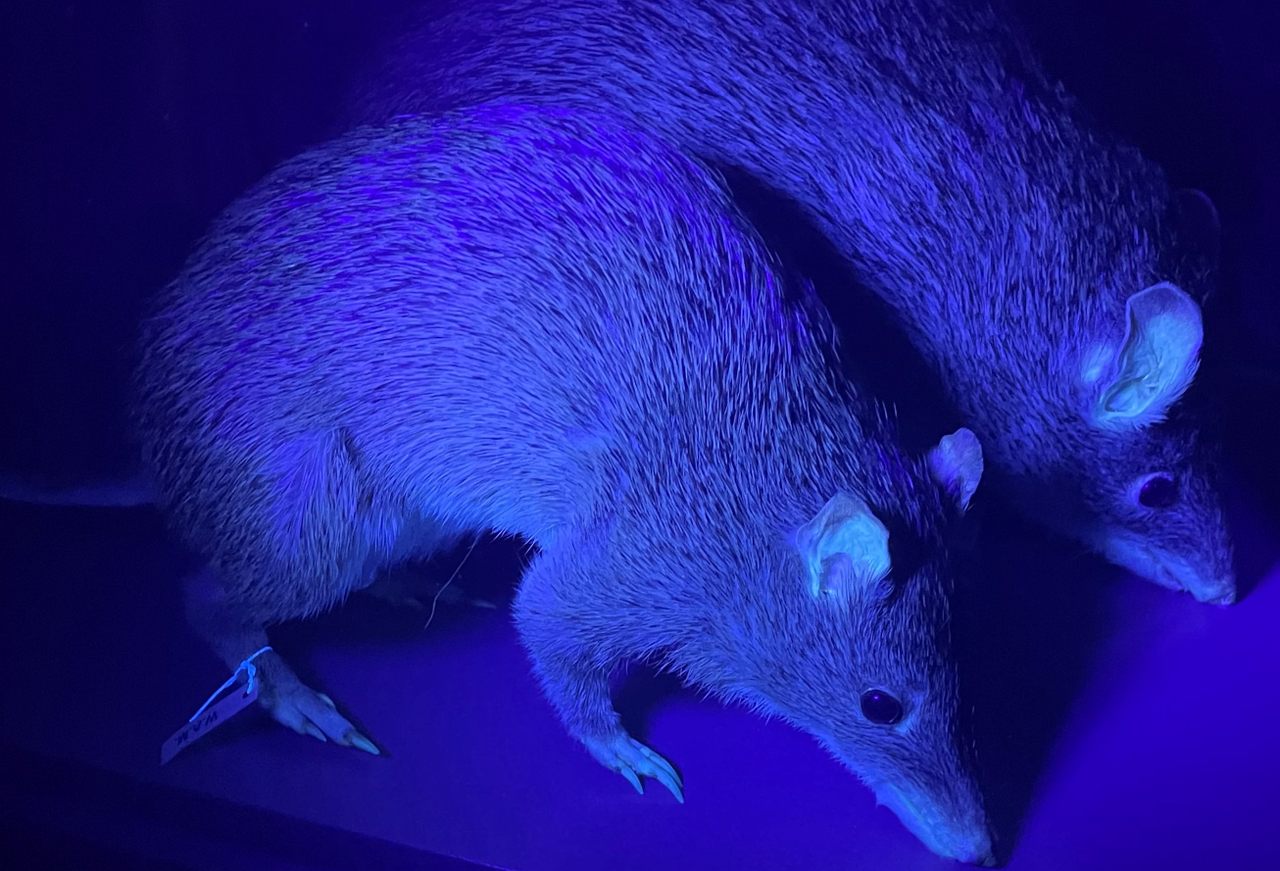Blacklight Studies Reveal That Most Mammals Secretly Glow
“It is, quite literally, seeing things in a whole new light.”
With its electroreceptor-spotted bill, horned pads where you might expect teeth, and status as one of only five species of mammals that lay eggs, the platypus was already one of the most unique creatures on Earth. And now researchers in the U.S. and Australia have found the animal exhibits another curious characteristic: fluorescence.
This intrigued Kenny Travouillon, the curator of mammalogy at the Western Australian Museum, and his colleagues, including research associate Linette Umbrello. “It was the first Australian mammal found to be fluorescent,” Travouillon says. Science has already uncovered how frogs light up the night and birds glow under a blacklight, but this discovery entered new animal territory. They decided to shine a UV light on their museum’s mammal collection (including preserved and frozen specimens), to see if any others glowed in the dark. The platypus wasn’t the odd one out, after all—they found the majority fluoresced.
“In some ways, this study confirms what’s been long suspected: fluorescence is the rule rather than the exception,” says Lisa Gershwin, the founder of Glow Show Tasmania and a marine biologist who’s conducted research on fluorescence. She says others, including herself and zoologist Linda Reinhold, have published papers about the topic, “but this study shows it on a massive scale.”

The findings also challenge the assumption that only nocturnal animals fluoresce. “Our study showed animals active during the day also do,” Travouillon says.
With so many mammals fluorescing, you might wonder if there’s a purpose to all this glowing. To sort through the possibilities, allow Travouillon to introduce you to the marsupial mole.
“It’s all white, blind, and spends most of its life underground,” Travouillon says. The marsupial mole has no use for fluorescence; it can’t see. Yet its body glows under UV light. Travouillon says the fluorescence is just about the fur color, not a specific function. The mole saves energy by not producing pigment, resulting in a white coat. White or pale fur contains proteins that shift UV light into the glow we see.

Pigment-free fur may also be the priority for polar bears, who need to be white to blend into their environment. “Fluorescence appears to be more well-developed in animals with pale fur,” says John Kirkwood, a marine biologist and expedition leader for Aurora Expeditions who spends a lot of time in the polar regions. “But is there anything about those mammals that gives them greater benefit than others? Or is it just a function of being pale?”
These questions have yet to be answered. And, Reinhold says, the musings are fairly recent. “Suggestions of a biological function only popped up in 2019, even though scientists since 1911 thought the characteristic was so ubiquitous it was unlikely to have an optical function,” she explains. Reinhold believes fluorescence probably doesn’t serve a visual purpose for most nocturnal animals (with the exception of species like the tube-nosed fruit bat, whose fluorescent spots have a camouflage function).
“There isn’t enough ambient light [at night] to set off fluorophores. Sunlight sets them off, so fluorescence is more likely to have a visual function in diurnal animals, but probably not at all,” she says. “As for biological function, it may act as some kind of sunscreen or whatever physiological function those molecules do in the fur structure.”

Other wildlife experts speculate fluorescence could help identify and signal members of the same species. In the Amazon frog study, researchers found body parts with the most intense fluorescence tended to be those used for communication and attracting mates. Mutulu Munyoki, a guide in Tsavo West National Park who’s spent his life observing wildlife in Kenya, also believes fluorescence can play a role in communication. “For example, the white tip of the leopard tail guides the way for cubs to follow mama in total silence,” he says, “and the white undertail fur of the lesser kudu helps them regroup without detection.”
Or perhaps there are functions we can’t see, linked to some animals’ ability to detect UV light (unlike humans who need the help of a light), as neuroscientist Lyn Beazley and her colleagues explored in a series of studies.
There are many possibilities—and that’s part of the process. “It’s interesting to speculate what the reasons might be, but that doesn’t mean that there is a reason,” Kirkwood says. “Scientists shouldn’t shy away from saying ‘We don’t know.’ Science advances by making observations, developing theories that may explain those observations, and then testing whether those theories are supported by experimental evidence.”
Which, Gershwin says, is exciting—not just for researchers, but for all of us. “We’re in the position where, due to smartphones and UV lights, observations are racing ahead of the science,” she says. “We know from experimentation that some species appear to use fluorescence. But for most, we’re still in the dark, and it requires more study. It isn’t often that a new world is discovered, but fluorescence is, in many ways, exactly that. It is, quite literally, seeing things in a whole new light.”


















Follow us on Twitter to get the latest on the world's hidden wonders.
Like us on Facebook to get the latest on the world's hidden wonders.
Follow us on Twitter Like us on Facebook